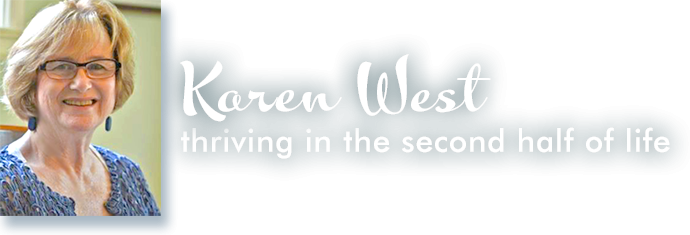This blog entry is the third entry on the topic of legacy. If you are new to this topic, you might want to read the last two entries.
Whenever I teach about legacy writing in my classes or workshops, I always begin by having my students write blessings. These blessings only need to be a few sentences which most often begin with “May you…” or “I wish for you…” or “I hope you…” My students always write their blessings in less than ten minutes, and they always agree that sharing a blessing it is a great way to show their love. Then after they have written their blessing, they can write it on a card or use it as the last sentence of a longer legacy letter. In my last blog entry, I shared a blessing for a friend of mine who had just retired. One of the sentences I wrote was “May you discover things to do that cause you to lose track of time.”
 But, of course, giving someone a whole legacy letter is even better, and there are so many kinds. I would like to begin by sharing the template for a four-paragraph legacy letter that Rachael Freed gives us in her book Your Legacy Matters: harvesting the love and lessons of your life. You can use this template when you decide to share one of your stories. In the first paragraph, you give the context of the experience. In the second you give the experience. In the third, you give “the lesson,” and in the last, you give the “blessing.”
But, of course, giving someone a whole legacy letter is even better, and there are so many kinds. I would like to begin by sharing the template for a four-paragraph legacy letter that Rachael Freed gives us in her book Your Legacy Matters: harvesting the love and lessons of your life. You can use this template when you decide to share one of your stories. In the first paragraph, you give the context of the experience. In the second you give the experience. In the third, you give “the lesson,” and in the last, you give the “blessing.”
In her book, Rachael gives several examples of legacy letters, but my favorite is the one she wrote for her children Sid and Debbie, which is on P. 26. In the first paragraph–the context–she tells them that in 1961, she was 22 and living and teaching in NYC. In the second paragraph—the experience—she tells them that one day when she was riding the subway, a pregnant, homeless woman began to beg. Rachael tells them that she did not engage with the woman. Instead, she averted her eyes, as did everyone else. Then the woman began to shout at the people, saying she was a human being, and so they should at least look her in the face. In the third paragraph—the lesson—Rachael says that she was “shocked and shamed,” and she learned the lesson that the homeless woman tried to teach them that day. And finally, she concluded her letter with a blessing.
 I love the idea of sharing an experience that you learned something from with your loved ones. I’m guessing that as I write this, hoping to encourage you to do this, some of you are thinking “I don’t have any experiences that anyone would care about.” I disagree, and so does Daniel Taylor. In his book Creating a Spiritual Legacy: How to Share Your Stories, Values, and Wisdom, he writes, “Telling your stories is the central act of a spiritual legacy. It is not a self-indulgence or passing entertainment. As part of a spiritual legacy, telling your stories is the fulfillment of a responsibility—the responsibility to pass on wisdom. It doesn’t matter whether you feel you have wisdom—your stories do.” (xi)
I love the idea of sharing an experience that you learned something from with your loved ones. I’m guessing that as I write this, hoping to encourage you to do this, some of you are thinking “I don’t have any experiences that anyone would care about.” I disagree, and so does Daniel Taylor. In his book Creating a Spiritual Legacy: How to Share Your Stories, Values, and Wisdom, he writes, “Telling your stories is the central act of a spiritual legacy. It is not a self-indulgence or passing entertainment. As part of a spiritual legacy, telling your stories is the fulfillment of a responsibility—the responsibility to pass on wisdom. It doesn’t matter whether you feel you have wisdom—your stories do.” (xi)
I hope I have piqued your interest in writing legacy letters for your loved ones. And for those of you who think that writing would take too much time, Rachael teaches that you can actually write a good first draft in 30 minutes. In fact, it’s best if you don’t take too long to write the first draft so your letter won’t be overly long. But I understand if you’re hesitant to try doing this; I was too. But once I actually started writing, I realized it wasn’t that hard, and when I reread the first one I wrote, I could see how much someone would appreciate receiving one. I know I would be thrilled if someone took the time to write one for me.
This blog entry is the third entry on the topic of legacy. If you are new to this topic, you might want to read the last two entries.
Whenever I teach about legacy writing in my classes or workshops, I always begin by having my students write blessings. These blessings only need to be a few sentences which most often begin with “May you…” or “I wish for you…” or “I hope you…” My students always write their blessings in less than ten minutes, and they always agree that sharing a blessing it is a great way to show their love. Then after they have written their blessing, they can write it on a card or use it as the last sentence of a longer legacy letter. In my last blog entry, I shared a blessing for a friend of mine who had just retired. One of the sentences I wrote was “May you discover things to do that cause you to lose track of time.”
But, of course, giving someone a whole legacy letter is even better, and there are so many kinds. I would like to begin by sharing the template for a four-paragraph legacy letter that Rachael Freed gives us in her book Your Legacy Matters: harvesting the love and lessons of your life. You can use this template when you decide to share one of your stories. In the first paragraph, you give the context of the experience. In the second you give the experience. In the third, you give “the lesson,” and in the last, you give the “blessing.”
In her book, Rachael gives several examples of legacy letters, but my favorite is the one she wrote for her children Sid and Debbie, which is on P. 26. In the first paragraph–the context–she tells them that in 1961, she was 22 and living and teaching in NYC. In the second paragraph—the experience—she tells them that one day when she was riding the subway, a pregnant, homeless woman began to beg. Rachael tells them that she did not engage with the woman. Instead, she averted her eyes, as did everyone else. Then the woman began to shout at the people, saying she was a human being, and so they should at least look her in the face. In the third paragraph—the lesson—Rachael says that she was “shocked and shamed,” and she learned the lesson that the homeless woman tried to teach them that day. And finally, she concluded her letter with a blessing.
I love the idea of sharing an experience that you learned something from with your loved ones. I’m guessing that as I write this, hoping to encourage you to do this, some of you are thinking “I don’t have any experiences that anyone would care about.” I disagree, and so does Daniel Taylor. In his book Creating a Spiritual Legacy: How to Share Your Stories, Values, and Wisdom, he writes, “Telling your stories is the central act of a spiritual legacy. It is not a self-indulgence or passing entertainment. As part of a spiritual legacy, telling your stories is the fulfillment of a responsibility—the responsibility to pass on wisdom. It doesn’t matter whether you feel you have wisdom—your stories do.” (xi)
I hope I have piqued your interest in writing legacy letters for your loved ones. And for those of you who think that writing would take too much time, Rachael teaches that you can actually write a good first draft in 30 minutes. In fact, it’s best if you don’t take too long to write the first draft so your letter won’t be overly long. But I understand if you’re hesitant to try doing this; I was too. But once I actually started writing, I realized it wasn’t that hard, and when I reread the first one I wrote, I could see how much someone would appreciate receiving one. I know I would be thrilled if someone took the time to write one for me.

